26 Search Results for fair testing practices
March 7, 2024
by Carole Zangari -
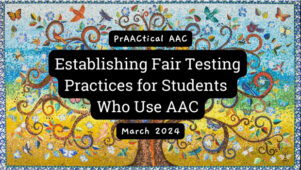
Students who use AAC are often tested in ways that set them up for failure. A few years back, we published a series on using Fair Testing Practices with ideas on how to improve our assessment practices. Today, we are resharing those articles for you to explore. What Are AAC Fair Testing Practices & Why Should We Use Them? Preparation for the Assessment Modes of Responding in Tests & Assessments The Testing Environment Test Materials Test Administration Procedures Communication & Documentation Implementation and Beyond
November 22, 2021
by Carole Zangari -
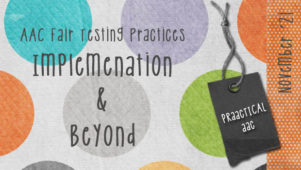
Fair testing practices based on individual needs, abilities, and priorities can be a game-changer for people who use AAC. These are created when teams* come together to engage in collaborative problem-solving and develop a set of guidelines that address an important question: How can we assess this individual so that we are tapping into what they actually know? You can see previous posts in this series here. What Are AAC Fair Testing Practices & Why Should We Use Them? Preparation for the Assessment Modes of Responding in Tests & Assessments The Testing Environment Test Materials Test Administration Procedures Communication & Documentation Today, we explore two final topics. First, we’ll think about the transition from planning our AAC fair testing practices to actually implementing them. Secondly, we’ll consider ways to continue the conversation about these practices with an eye on continuing to refine them over time. TOPIC 14 Implementation: How can... [Read More...]
November 18, 2021
by Carole Zangari -
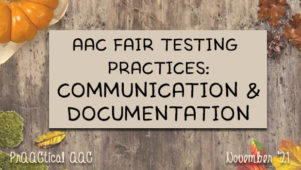
We’re continuing to discuss strategies for helping teams devise ways to test students who use AAC in ways that allow them to show what they actually know in test-taking situations. For the most part, this involves team discussions and collaborative problem-solving to develop a plan based on each AAC user’s individual needs, abilities, and priorities. Today’s post addresses two important topics: How individuals will communicate during testing and how teams document the ways that assessments are administered to a particular individual. TOPIC 12 Communicating During Testing – How will students express themselves during testing? People who use AAC should always have easy access to the tools they use for communication. In testing, professionals may be tempted to remove or restrict the AAC device during testing, but there are several reasons why this is not a good idea. For starters, we’re violating basic human rights in making communication aids less accessible.... [Read More...]
November 4, 2021
by Carole Zangari -
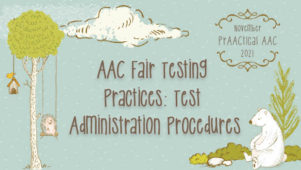
Without a thoughtful assessment plan in place, people who use AAC may be at a disadvantage when taking tests. Fatigue, excessive anxiety, comprehension difficulties, motor challenges, limited access to robust language, and other factors may make it difficult for them to demonstrate what they know. Today, we continue our series on AAC Fair Testing Practices with a discussion of test administration practices. In formal testing, any changes to testing procedures invalidate the use of normative data. If we modify the directions or response options provided to an AAC user, we can’t compare their scores to the scores of individuals who took the test without any modifications. That means we aren’t pouring through the tables at the back of the test manual to find age or grade equivalency scores. Still, we have to be thoughtful in when and how to make adjustments to testing practices. In this post, we consider two... [Read More...]
October 28, 2021
by Carole Zangari -
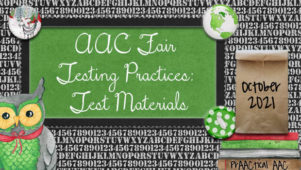
For individuals with AAC needs to be able to demonstrate what they know in assessment situations, we need to think carefully about the test materials and consider what adjustments are needed. In this continuation of our series on AAC Fair Testing Practices, we’ll explore this in some detail. TOPIC 9: Test Materials There are two categories of test materials for us to consider: those that are part of the assessment process for all learners and those that may be needed primarily by students who use AAC. In both cases, teams should discuss what is relevant, fair, and helpful to a particular student. Detailed notes should be kept to aid in replicating the set-up for re-testing at a later point in time or for use in other assessments. Additionally, teams will want to keep the purpose of the assessment in mind as they address this topic. Knowing why we are conducting... [Read More...]
October 14, 2021
by Carole Zangari -
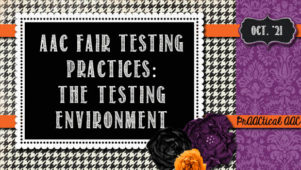
Today, we’re continuing our discussion of Fair Testing Practices for people who use AAC and need to participate in assessments. So far, we’ve talked about the rationale for this approach and considered things that we need to address in two areas: Preparation for the assessment and the various options for how to respond when faced with different types of test questions (e.g., multiple-choice, fill-in-the-blank). In this post, we turn our attention to things that impact the test environment. Topic 7: Can anyone test this student or are there specific skills and characteristics that the evaluator should possess? There are many things that influence our performance on tests. For individuals who use AAC, it’s important to consider who will be administering the assessment. Here are some topics that teams can discuss to approach this in a way that will be fair to the AAC user. AAC Knowledge and Skills: In most... [Read More...]
September 23, 2021
by Carole Zangari -
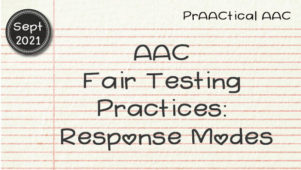
Over the past few weeks, we’ve been talking about the concept of Fair Testing Practices and how that might apply to people who use AAC. If you missed those posts, you can check them out using the links below. Introduction to Fair Testing Practices in AAC AAC Fair Testing Practices: Preparation In today’s post, we consider how students will respond to a number of testing situations. Teams can explore each of the topics listed below, brainstorm possible solutions, and work together to make decisions about how the student will respond with forced-choice questions, open-ended questions, and test items that require physical manipulation of test materials. Topic 4: How will the student answer forced-choice questions, such as true/false or multiple-choice questions? Many AAC users can answer these types of questions the same way that their speaking peers do. Adjustments may be needed for individuals with fine motor difficulties, such as... [Read More...]
September 2, 2021
by Carole Zangari -
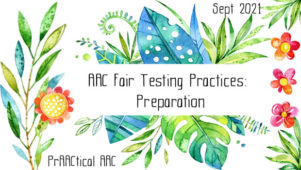
In an earlier post, we talked about the difficulties that people who use AAC experience when they have to participate in tests or other assessments for educational or therapeutic purposes. (You can see that post here.) One approach to addressing these challenges is for key stakeholders to come together and develop a set of guidelines that teachers, therapists, and others can use when they need to administer an assessment. Today, we’ll look at some of the guiding questions that teams can use to develop these Fair Testing Practices. The idea here is that AAC users, families, professionals, and other team members can come together to discuss a number of specific issues regarding preparation, materials, means of answering questions, etc. Later in the series, we’ll talk about ways to facilitate meaningful participation by individuals who use AAC but are still developing their communication and language skills. For the time being, though,... [Read More...]
August 23, 2021
by Carole Zangari -
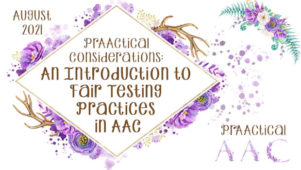
Why do students who use AAC have difficulty showing what they know when taking tests and quizzes? More than a decade ago, Lisa Proctor and I wrote about the unfair ways that students who use AAC are tested in the book Practically Speaking: Language, Literacy, and Academic Development for Students with AAC Needs that I co-edited with Gloria Soto. Later, I wrote about that on these pages, too, discussing how we set them up for failure in our current practices (see PrAACtically Unfair: Why People Who Use AAC Sometimes Fail at Tests). As I talk to educators, clinicians, families, and AAC users, it seems that little has changed, at least here in the US. AAC users are still routinely tested in ways that set them up for failure. We don’t test what a 4-year-old knows about animals by having them write about the subject. Why? Because they can’t write well... [Read More...]
January 6, 2022
by Carole Zangari -
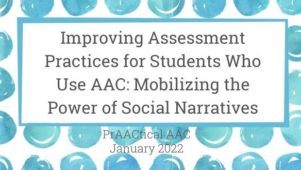
Social narratives are an empirically supported intervention that can be helpful in supporting people with AAC needs. They are commonly used to help individuals with autism understand and deal with challenging situations such as fire drills, birthday parties, and trips to the dentist. All types of social narratives can be written in text alone or include pictures and illustrations. Social Stories are a particular kind of social narrative that have a specific set of guidelines for their development and use. The originator of Social Stories, Carol Gray, defines Social Stories this way: “A Social Story accurately describes a context, skill, achievement, or concept according to 10 defining criteria. These criteria guide Story research, development, and implementation to ensure an overall patient and supportive quality, and a format, ‘voice’, content, and learning experience that is descriptive, meaningful, respectful, and physically, socially, and emotionally safe for the Story audience (a child, adolescent,... [Read More...]









